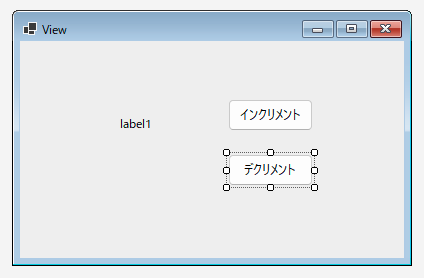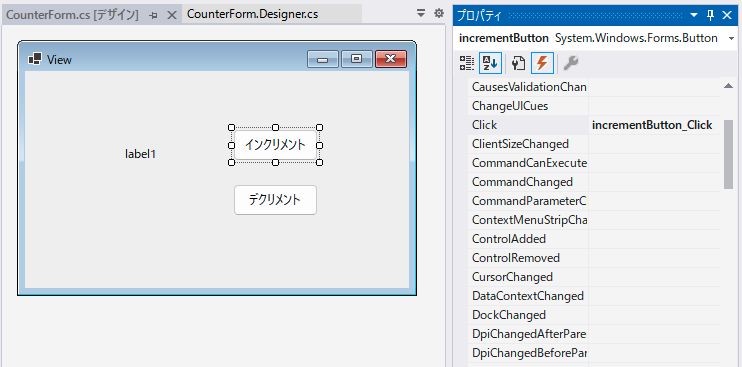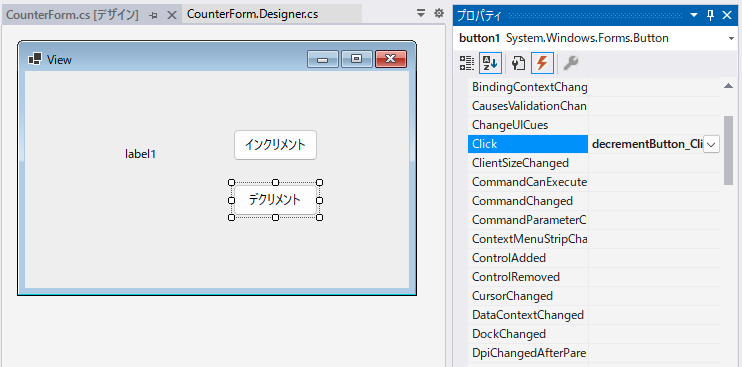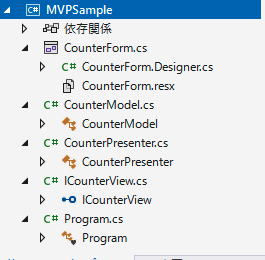WindowsFormsアプリでのMVPパターンサンプル
以下は、WindowsFormsアプリでMVCパターンを実装するための簡単なサンプルです
目次
MVPとは
MVPは、MVCに似たデザインパターンで、ModelとViewを分離し、Presenterを介して連携することで、アプリケーションの保守性や拡張性を向上することを目的とします。Presenterは、Viewからの入力を処理し、Modelからのデータを受け取ってViewを更新する役割を担います。
クラス図

サンプル概要
この例では、Modelクラスでカウンターの値を保持し、Viewクラスではカウンターの値を表示するUIを作成しています。Presenterクラスは、ViewとModelを連携し、ユーザーの入力に応じてModelを更新し、Viewを更新します。ICounterViewインターフェースは、Viewクラスによって実装され、PresenterがViewを更新するために使用されます。
このように、MVPパターンを使用することで、アプリケーションの保守性や拡張性を向上することができます。また、Presenterを使用することで、ビジネスロジックとUIを分離し、テストを容易にすることもできます。
実行結果
フォームデザイン
ラベルを1つとボタンを2つ配置します

ボタンのクリックのイベントを登録します


ソリューション

コード
Model
namespace MVPSample
{
public class CounterModel
{
private int count = 0;
public int Count
{
get { return count; }
set { count = value; }
}
public void Increment()
{
count++;
}
public void Decrement()
{
count--;
}
}
}
View
namespace MVPSample
{
public partial class CounterForm : Form, ICounterView
{
private CounterPresenter presenter;
public CounterForm()
{
InitializeComponent();
presenter = new CounterPresenter(this, new CounterModel());
}
public void UpdateCount(int count)
{
countLabel.Text = count.ToString();
}
private void incrementButton_Click(object sender, EventArgs e)
{
presenter.Increment();
}
private void decrementButton_Click(object sender, EventArgs e)
{
presenter.Decrement();
}
}
}namespace MVPSample
{
partial class CounterForm
{
/// <summary>
/// Required designer variable.
/// </summary>
private System.ComponentModel.IContainer components = null;
/// <summary>
/// Clean up any resources being used.
/// </summary>
/// <param name="disposing">true if managed resources should be disposed; otherwise, false.</param>
protected override void Dispose(bool disposing)
{
if (disposing && (components != null))
{
components.Dispose();
}
base.Dispose(disposing);
}
#region Windows Form Designer generated code
/// <summary>
/// Required method for Designer support - do not modify
/// the contents of this method with the code editor.
/// </summary>
private void InitializeComponent()
{
this.countLabel = new System.Windows.Forms.Label();
this.incrementButton = new System.Windows.Forms.Button();
this.button1 = new System.Windows.Forms.Button();
this.SuspendLayout();
//
// countLabel
//
this.countLabel.AutoSize = true;
this.countLabel.Location = new System.Drawing.Point(97, 75);
this.countLabel.Name = "countLabel";
this.countLabel.Size = new System.Drawing.Size(38, 15);
this.countLabel.TabIndex = 0;
this.countLabel.Text = "label1";
//
// incrementButton
//
this.incrementButton.Location = new System.Drawing.Point(208, 58);
this.incrementButton.Name = "incrementButton";
this.incrementButton.Size = new System.Drawing.Size(85, 32);
this.incrementButton.TabIndex = 1;
this.incrementButton.Text = "インクリメント";
this.incrementButton.UseVisualStyleBackColor = true;
this.incrementButton.Click += new System.EventHandler(this.incrementButton_Click);
//
// button1
//
this.button1.Location = new System.Drawing.Point(208, 113);
this.button1.Name = "button1";
this.button1.Size = new System.Drawing.Size(85, 32);
this.button1.TabIndex = 2;
this.button1.Text = "デクリメント";
this.button1.UseVisualStyleBackColor = true;
this.button1.Click += new System.EventHandler(this.decrementButton_Click);
//
// CounterForm
//
this.AutoScaleDimensions = new System.Drawing.SizeF(7F, 15F);
this.AutoScaleMode = System.Windows.Forms.AutoScaleMode.Font;
this.ClientSize = new System.Drawing.Size(384, 217);
this.Controls.Add(this.button1);
this.Controls.Add(this.incrementButton);
this.Controls.Add(this.countLabel);
this.Name = "CounterForm";
this.Text = "View";
this.ResumeLayout(false);
this.PerformLayout();
}
#endregion
private Label countLabel;
private Button incrementButton;
private Button button1;
}
}Presenter
namespace MVPSample
{
public class CounterPresenter
{
private ICounterView view;
private CounterModel model;
public CounterPresenter(ICounterView view, CounterModel model)
{
this.view = view;
this.model = model;
view.UpdateCount(model.Count);
}
public void Increment()
{
model.Increment();
view.UpdateCount(model.Count);
}
public void Decrement()
{
model.Decrement();
view.UpdateCount(model.Count);
}
}
}
Program.cs
namespace MVPSample
{
internal static class Program
{
/// <summary>
/// The main entry point for the application.
/// </summary>
[STAThread]
static void Main()
{
// To customize application configuration such as set high DPI settings or default font,
// see https://aka.ms/applicationconfiguration.
ApplicationConfiguration.Initialize();
Application.Run(new CounterForm());
}
}
}訪問数 124 回, 今日の訪問数 1回





ディスカッション
コメント一覧
まだ、コメントがありません